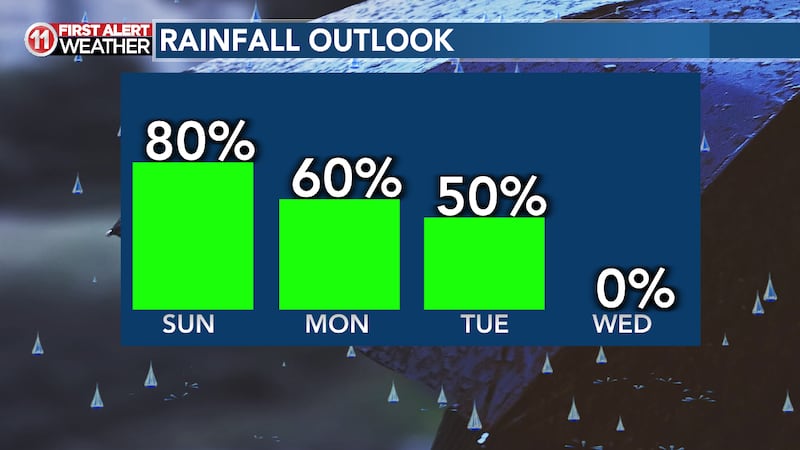When To Expect Rain: Updated Forecasts And Timing

Understanding Different Types of Rain Forecasts
Accurately predicting when and how much it will rain depends heavily on understanding the different types of rain forecasts available. The timeframe of the forecast significantly impacts its accuracy and usefulness.
-
Short-term rain forecasts (hourly, daily): These are best for immediate planning, providing highly accurate predictions within a few hours. You can use these to decide whether to grab an umbrella on your way to work or postpone a short outdoor activity. The accuracy is high because the atmospheric conditions are closer to the forecast time.
-
Medium-term forecasts (2-7 days): Useful for planning events a few days out, such as a weekend picnic or a sporting event. However, the accuracy decreases with time as the atmospheric conditions become more unpredictable. Expect a higher margin of error compared to short-term rain forecasts.
-
Long-term rain predictions (weekly, monthly): These forecasts provide a general trend of expected precipitation, indicating whether a week or month will be wetter or drier than average. However, specific details like the exact timing and intensity of rainfall are far less reliable. Think of these as broad weather patterns, not precise predictions.
Forecast accuracy is influenced by numerous factors, including the sophistication of weather models, the availability of observational data, and the inherent chaotic nature of the atmosphere. It's important to understand that no rain forecast is perfect; always account for a degree of uncertainty.
Reliable Sources for Rain Forecasts
Staying informed about impending rain requires accessing reliable sources for rain forecasts. Several excellent options exist, and using multiple sources often provides a more comprehensive picture.
-
National meteorological services: Organizations like the National Oceanic and Atmospheric Administration (NOAA) in the US, the Met Office in the UK, and similar agencies worldwide provide highly accurate and detailed weather forecasts, including specific rain forecasts. These services utilize advanced models and extensive data networks.
-
Reputable weather apps: Many popular weather apps, such as AccuWeather, The Weather Channel, and WeatherBug, offer detailed rain forecasts, often incorporating data from national meteorological services. Choose well-reviewed apps known for their accuracy.
-
Local news and weather channels: Local news broadcasts often provide localized rain forecasts, offering valuable insights into hyperlocal conditions that national services might miss.
-
Hyperlocal weather websites or forums: For specific areas, especially smaller towns or regions, dedicated hyperlocal weather websites or online forums may offer community-sourced observations and supplementary rain forecasts.
Always cross-reference information from multiple sources to confirm the consistency of the rain forecast before making critical decisions.
Interpreting Rain Forecast Data
Understanding how rain forecasts are presented is crucial for effective planning. Common symbols and data require careful interpretation.
-
Probability of Precipitation (PoP): This represents the chance of measurable rainfall (at least 0.01 inches) occurring at a specific location during a given time period. A PoP of 60% doesn't mean it will rain for 60% of the time, but rather that there's a 60% chance of at least some rain.
-
Rain amount predictions: Forecasts often indicate the expected amount of rainfall, typically in inches or millimeters. This helps you gauge the potential intensity and impact of the rain.
-
Rainfall intensity: Forecasts usually describe rainfall intensity as light, moderate, or heavy. This helps you prepare accordingly – light rain may require a light jacket, while heavy rain might warrant staying indoors.
-
Forecast terminology: Familiarize yourself with common terms like "scattered showers," which indicates patchy rain, "showers likely," suggesting a higher chance of rain, and "periods of rain," implying sustained rainfall.
(Include visual aids here – sample forecast images with explanations of the symbols and data presented)
Advanced Techniques for Predicting Rain
For a more in-depth understanding of rain forecasts, exploring advanced techniques can enhance predictive capabilities.
-
Using radar imagery: Weather radar provides real-time images of precipitation, showing the location, intensity, and movement of rain. This allows for more precise short-term predictions.
-
Understanding atmospheric pressure systems: Learning about high and low-pressure systems, fronts, and other atmospheric phenomena significantly improves the understanding of the atmospheric dynamics leading to rain.
-
Utilizing specialized resources: Dedicated weather blogs, meteorological websites, and university research departments often provide detailed analyses and forecasts that go beyond basic weather apps.
These advanced techniques are particularly helpful for weather enthusiasts and those who need highly accurate, localized rain forecasts.
Conclusion
Knowing when to expect rain is essential for planning any outdoor activity. By utilizing the various resources and techniques outlined above — from understanding different forecast types to interpreting complex data and using advanced tools like radar — you can significantly improve your ability to predict rainfall and make informed decisions. Regularly check the latest rain forecast updates from reliable sources, and remember that even the best predictions have inherent limitations. Stay prepared, stay informed, and check your local rain forecast frequently for the most up-to-date information.

 Suomen Jalkapallomaajoukkue Uusi Valmennus Ja Mm Karsinnat
Suomen Jalkapallomaajoukkue Uusi Valmennus Ja Mm Karsinnat
 Complete Nyt Mini Crossword Solutions March 13 2024
Complete Nyt Mini Crossword Solutions March 13 2024
 Planning Your Day Mild Temperatures Minimal Rain
Planning Your Day Mild Temperatures Minimal Rain
 Michael Schumacher De Mallorca A Suiza En Helicoptero Para Conocer A Su Nieta
Michael Schumacher De Mallorca A Suiza En Helicoptero Para Conocer A Su Nieta
 Wwe Raw The Brutal Assault On Sami Zayn By Rollins And Breakker
Wwe Raw The Brutal Assault On Sami Zayn By Rollins And Breakker
